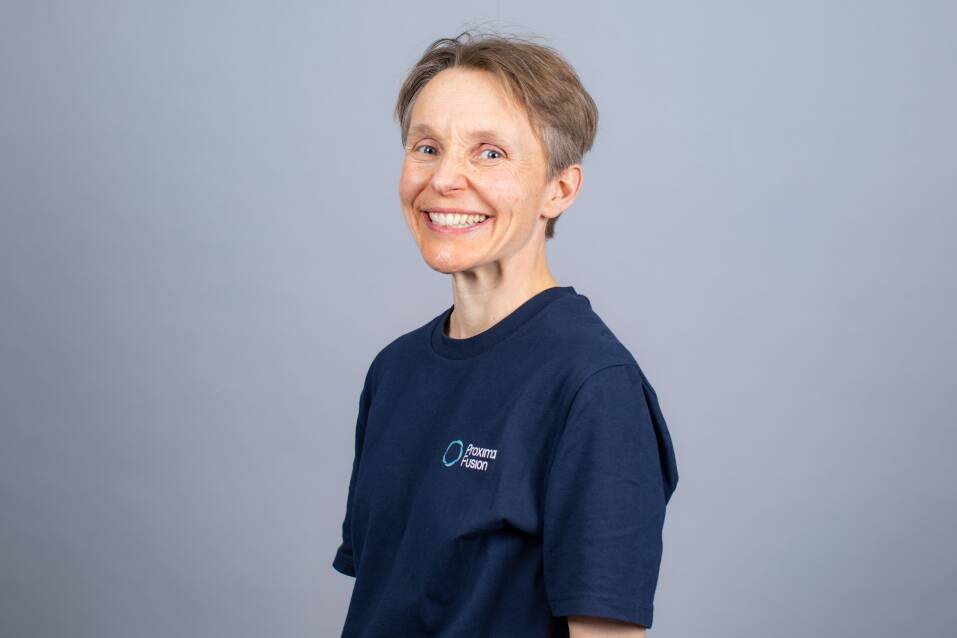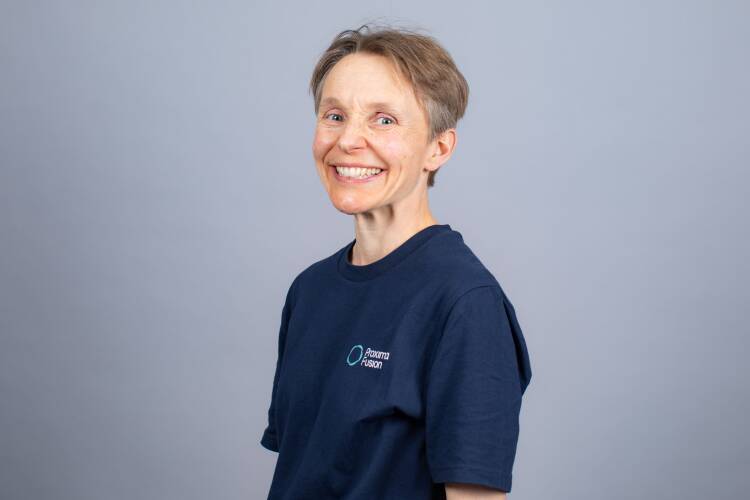As the fusion energy landscape evolves at unprecedented speed, collaboration between public institutions and private ventures becomes more vital than ever. Proxima Fusion, a private fusion company spun out of the Max Planck Institute for Plasma Physics, is one of the newest arrivals at Culham Campus. Jenny Cane, Senior Lead Engineer at Proxima Fusion, highlighted why the company chose Culham Campus for its UK base, how public-private collaboration is shaping the future of fusion, and what advice she has for those looking to join this transformative field.
Can you tell us a bit about yourself and your role at Proxima Fusion?
I’m Jenny Cane, Senior Lead Engineer for the Alpha concept design at Proxima Fusion. Alpha is our net-energy demonstrator, a key step toward building Proxima’s first fusion power plant in the 2030s. My background includes over 11 years at UKAEA, working across a variety of roles including major contributions to STEP (Spherical Tokamak for Energy Production). Proxima Fusion are researching stellarators, which also present a number of novel engineering challenges compared to tokamaks, but their design also brings opportunities on the path to delivering a commercial fusion powerplant.
Why did Proxima Fusion chose Culham Campus as its UK headquarters?
Culham is a uniquely valuable location for a company like ours. It provides proximity to UKAEA’s world-leading facilities and expertise, particularly in operating deuterium-tritium fusion machines, which is essential for Alpha. Beyond that, we have access to specialist facilities such as HIVE (Heating by Induction to Verify Extremes), the tritium fuel cycle labs, and materials testing capabilities. There’s also the day-to-day benefit of being part of a vibrant campus, where collaborative conversations can happen over coffee. It’s that informal but critical connectivity—between people and ideas—that really enhances innovation.
How do you see the collaboration between UKAEA and private fusion companies shaping the future of the industry?
It’s vital. UKAEA is beautifully positioned to develop the long-term, foundational technologies we all need—technologies that might be too high-risk or long-horizon for private companies to invest in alone. At the same time, private fusion companies like Proxima can fast-track the application of these technologies into commercial designs. It's a virtuous cycle—public sector investment lays the groundwork, and private industry drives delivery at pace. Together, we can accelerate the path to a commercially viable fusion energy future.
What kind of partnerships are Proxima Fusion looking to develop in the UK?
We’re particularly interested in targeted technical collaborations—partnerships that help us deliver Alpha and future machines. This includes design reviews, materials testing, component prototyping, and expert input on everything from safety systems to structual and thermal analysis. UKAEA’s depth of knowledge and capabilities is crucial here, and we’re keen to engage with others in the UK ecosystem who offer deep, focused expertise. We’re not trying to reinvent the wheel—we’re looking for the best collaborators to help build it better.
What advice would you give to companies or innovators considering partnering with UKAEA or joining the fusion ecosystem?
Identify what specific challenge you can solve. Fusion is now a delivery-driven environment. We’re looking for partners who bring targeted expertise—be it in advanced materials, extreme heat management, high magnetic field design, or fast prototyping. You don’t have to solve fusion by yourself. We need specialists who can fill in the gaps, quickly and effectively. Speed of delivery can be just as important as technical performance.
What advice would you offer individuals looking to work in fusion energy?
Don’t count yourself out. Fusion isn’t just for plasma physicists—it’s for materials scientists, software engineers, manufacturing experts, systems thinkers, and more. Embrace the complexity and be ready to learn, but also know that your existing skills are likely already needed. We need the best of every field, not polymaths who know it all. Come with curiosity, commitment, and a willingness to adapt.
What’s a standout memory from your career in fusion?
One of my favourites is from the Symposium On Fusion Engineering (SOFE) 2023 Conference in Oxford. We were presenting work done by the STEP team, and it was powerful to reflect on how far we’d come—and how much we’d achieved together. That sense of camaraderie, of shared progress, really stayed with me.
What excites you most about working in fusion right now?
The fact that it’s actually happening. When I started over a decade ago, fusion was still very much a research field. Now, we’re seeing private companies building machines, real momentum in supply chains, and serious investment. We’ve gone from theoretical to practical and competitive. That transformation—from lab to launchpad—is the most exciting part. It feels like we're standing at the edge of something extraordinary.
As Jenny Cane makes clear, fusion is no longer a scientific dream—it’s a global engineering challenge with commercial urgency. And as Proxima Fusion deepens its roots at Culham Campus, it becomes part of a thriving UK fusion cluster built on partnership, purpose, and pace. Whether you’re a start-up innovator, established supplier, or an individual looking for a meaningful career, the future of energy is being built today—and there’s room for everyone to contribute.
Spotlight Interview: Jenny Cane
Spotlight Interview: Jenny Cane
As the fusion energy landscape evolves at unprecedented speed, collaboration between public institutions and private ventures becomes more vital than ever. Proxima Fusion, a private fusion company spun out of the Max Planck Institute for Plasma Physics, is one of the newest arrivals at Culham Campus. Jenny Cane, Senior Lead Engineer at Proxima Fusion, highlighted why the company chose Culham Campus for its UK base, how public-private collaboration is shaping the future of fusion, and what advice she has for those looking to join this transformative field.
Can you tell us a bit about yourself and your role at Proxima Fusion?
I’m Jenny Cane, Senior Lead Engineer for the Alpha concept design at Proxima Fusion. Alpha is our net-energy demonstrator, a key step toward building Proxima’s first fusion power plant in the 2030s. My background includes over 11 years at UKAEA, working across a variety of roles including major contributions to STEP (Spherical Tokamak for Energy Production). Proxima Fusion are researching stellarators, which also present a number of novel engineering challenges compared to tokamaks, but their design also brings opportunities on the path to delivering a commercial fusion powerplant.
Why did Proxima Fusion chose Culham Campus as its UK headquarters?
Culham is a uniquely valuable location for a company like ours. It provides proximity to UKAEA’s world-leading facilities and expertise, particularly in operating deuterium-tritium fusion machines, which is essential for Alpha. Beyond that, we have access to specialist facilities such as HIVE (Heating by Induction to Verify Extremes), the tritium fuel cycle labs, and materials testing capabilities. There’s also the day-to-day benefit of being part of a vibrant campus, where collaborative conversations can happen over coffee. It’s that informal but critical connectivity—between people and ideas—that really enhances innovation.
How do you see the collaboration between UKAEA and private fusion companies shaping the future of the industry?
It’s vital. UKAEA is beautifully positioned to develop the long-term, foundational technologies we all need—technologies that might be too high-risk or long-horizon for private companies to invest in alone. At the same time, private fusion companies like Proxima can fast-track the application of these technologies into commercial designs. It's a virtuous cycle—public sector investment lays the groundwork, and private industry drives delivery at pace. Together, we can accelerate the path to a commercially viable fusion energy future.
What kind of partnerships are Proxima Fusion looking to develop in the UK?
We’re particularly interested in targeted technical collaborations—partnerships that help us deliver Alpha and future machines. This includes design reviews, materials testing, component prototyping, and expert input on everything from safety systems to structual and thermal analysis. UKAEA’s depth of knowledge and capabilities is crucial here, and we’re keen to engage with others in the UK ecosystem who offer deep, focused expertise. We’re not trying to reinvent the wheel—we’re looking for the best collaborators to help build it better.
What advice would you give to companies or innovators considering partnering with UKAEA or joining the fusion ecosystem?
Identify what specific challenge you can solve. Fusion is now a delivery-driven environment. We’re looking for partners who bring targeted expertise—be it in advanced materials, extreme heat management, high magnetic field design, or fast prototyping. You don’t have to solve fusion by yourself. We need specialists who can fill in the gaps, quickly and effectively. Speed of delivery can be just as important as technical performance.
What advice would you offer individuals looking to work in fusion energy?
Don’t count yourself out. Fusion isn’t just for plasma physicists—it’s for materials scientists, software engineers, manufacturing experts, systems thinkers, and more. Embrace the complexity and be ready to learn, but also know that your existing skills are likely already needed. We need the best of every field, not polymaths who know it all. Come with curiosity, commitment, and a willingness to adapt.
What’s a standout memory from your career in fusion?
One of my favourites is from the Symposium On Fusion Engineering (SOFE) 2023 Conference in Oxford. We were presenting work done by the STEP team, and it was powerful to reflect on how far we’d come—and how much we’d achieved together. That sense of camaraderie, of shared progress, really stayed with me.
What excites you most about working in fusion right now?
The fact that it’s actually happening. When I started over a decade ago, fusion was still very much a research field. Now, we’re seeing private companies building machines, real momentum in supply chains, and serious investment. We’ve gone from theoretical to practical and competitive. That transformation—from lab to launchpad—is the most exciting part. It feels like we're standing at the edge of something extraordinary.
As Jenny Cane makes clear, fusion is no longer a scientific dream—it’s a global engineering challenge with commercial urgency. And as Proxima Fusion deepens its roots at Culham Campus, it becomes part of a thriving UK fusion cluster built on partnership, purpose, and pace. Whether you’re a start-up innovator, established supplier, or an individual looking for a meaningful career, the future of energy is being built today—and there’s room for everyone to contribute.

